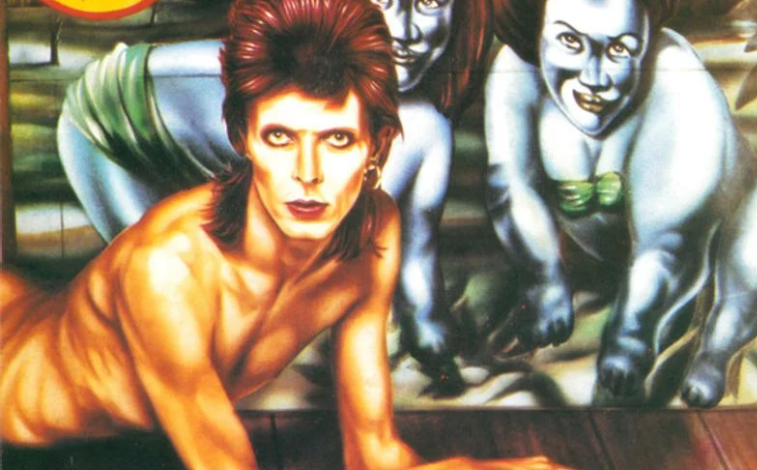Why ‘Diamond Dogs’ is David Bowie’s best all-rounder

David Bowie grew to prominence like an English Oak – very slowly. He was limited by the nature of his early material, which seemed somewhat detached from the normal bounds of 1960s pop music with its tongue in cheek sound that one feels would have been more at home in a bizarre nursery rhyme stage production. Alas, Bowie’s 1967 debut album was a critical disappointment and so marked the beginning of a quiet two years for the frustrated artist.
His early glimmer of hope was seen with the release of Space Oddity in 1969, which was buoyed by the international success of its title track. However, it wasn’t until the early 1970s, with the release of Hunky Dory in 1971 and The Rise and Fall of Ziggy Stardust and The Spiders From Mars a year later, that Bowie became a global sensation.
This success came with the arrival of Bowie’s first major alter ego persona, Ziggy Stardust. Before releasing his follow-up seventh album, Aladdin Sane, in 1973, Bowie had already retired the persona and was toying with the next. This constant metamorphosis and reinvention would ultimately continue to define Bowie’s long and illustrious career, and it was something that helped him remain relevant for so many years.
As his personas changed, so too did the music. When thinking of the most quintessential Bowie sound, one might think of the glam era of the early 1970s, the soul-infused era of the mid-1970s, his more experimental work with Brian Eno in the late 1970s or even his pop-oriented, self-confessed “Phil Collins years” in the 1980s.
Because of the obvious eclecticism, it’s exceedingly difficult to pick out just one Bowie album that is the most all-encompassing – one that covers most of Bowie’s bases at once. Recently, I was asked what Bowie album I would recommend to someone who wants to get into the Starman’s music having heard only the odd hit.
Naturally, one would be mad to throw their friend in the deep end with one of the more experimental records of the Berlin trilogy, despite them holding what is, in my opinion, some of Bowie’s greatest work. Instead, I found myself narrowing it down to three. Ziggy Stardust, Station to Station, and Scary Monsters (and Super Creeps). With these three seminal classics, one could become acquainted with the most important aspects and eras of Bowie’s career while getting to know a good deal of his best tracks.
Choosing these three, however, was a bit of a cop-out. The real challenge here was to pick out just one album. So I then thought, if I was tasked with sending one Bowie LP into space to show extra-terrestrials what Bowie’s music was like, what would it be? After chewing it over for a moment, I decided that the only satisfying answer was 1974’s Diamond Dogs.
While not often regarded as one of Bowie’s finest albums, I feel that it is often overlooked due to the grandeur of Ziggy Stardust and Bowie’s late 1970s deviation from glam. Perhaps this was the downfall of Diamond Dogs; it’s neither here nor there. It bridges the gap between the glam rock era of the early 1970s and the more soul orientated mid-70s that would reach its pinnacle in 1975 with Young Americans.
Not only does the album bridge this gap, but it brings an interestingly vast collection of ideas into just one 38-minute album. It begins with the one-minute intro, ‘Future Legend’, which sets the apocalyptic scene of the record with Bowie’s William Burroughs inspired spoken-word narrative. The song seems to throwback to the nursery rhyme feel of Bowie’s eponymous debut album from 1967.
Sticking to the running theme of literature inspired dystopia, the album holds two tracks directly influenced by George Orwell’s classic novel, 1984, ‘1984’ and ‘Big Brother’. Elsewhere, Bowie introduces his new stage persona, Halloween Jack, in the lyrics of the album’s title track which comes as a throwback to the glam style perfected in Ziggy Stardust two years before.
The album’s lead single, ‘Rebel Rebel’, gives the album its significance among casual fans, and while it’s overplayed, it’s one of Bowie’s most iconic rock-outs and gives the album a much-welcomed injection of pace.
The album’s hidden gem comes in the form of ‘Sweet Thing’, which is often heard as just one of its three parts – in a similar way to Pink Floyd’s ‘Another Brick in the Wall’. The three-part suite consists of ‘Sweet Thing Pt.1’, ‘Candidate’ and ‘Sweet Thing Pt. 2’ and clocks in at eight minutes and 50 seconds. The epic brings balance with its slow, brooding atmosphere that foreshadows the creative direction of Young Americans, while the complex composition and tempo changes across the three parts point forwards toward the title track of 1976’s Station to Station.
While no singular Bowie album can encapsulate his uniquely diverse and multifaceted career, Diamond Dogs seems to glue together a significant amalgam of his most essential phases and milestones. The album is definitely not his greatest, but it is definitely one of his most well balanced and all-encompassing records.





